NISSAN 370Z COUPE 2010 Owners Manual
Manufacturer: NISSAN, Model Year: 2010, Model line: 370Z COUPE, Model: NISSAN 370Z COUPE 2010Pages: 409, PDF Size: 3.56 MB
Page 311 of 409
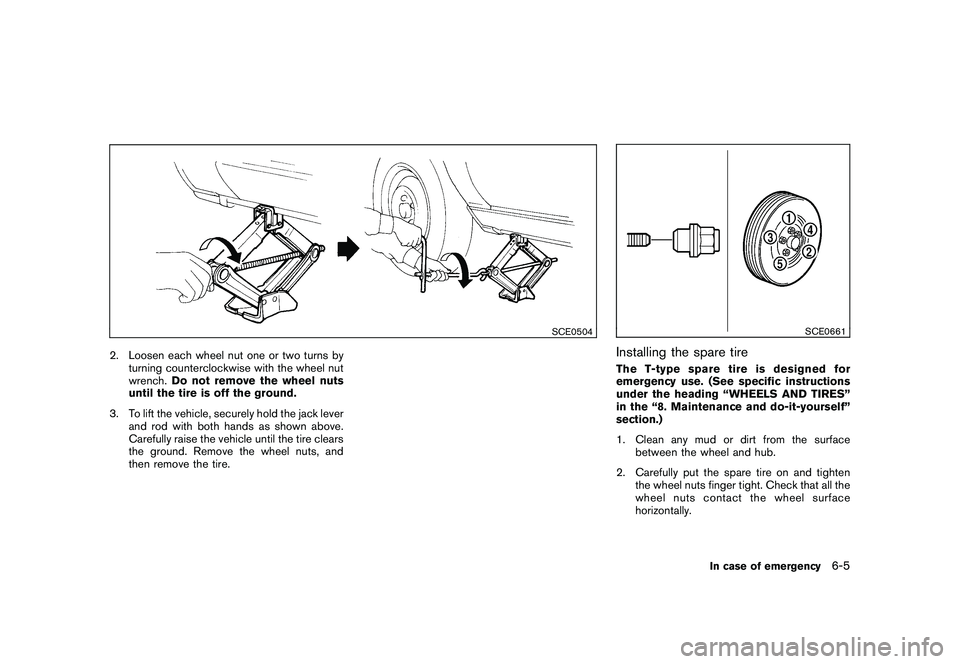
Black plate (311,1)
Model "Z34-D" EDITED: 2009/ 9/ 10
SCE0504
2. Loosen each wheel nut one or two turns byturning counterclockwise with the wheel nut
wrench. Do not remove the wheel nuts
until the tire is off the ground.
3. To lift the vehicle, securely hold the jack lever and rod with both hands as shown above.
Carefully raise the vehicle until the tire clears
the ground. Remove the wheel nuts, and
then remove the tire.
SCE0661
Installing the spare tireThe T-type spare tire is designed for
emergency use. (See specific instructions
under the heading “WHEELS AND TIRES”
in the “8. Maintenance and do-it-yourself”
section.)
1. Clean any mud or dirt from the surfacebetween the wheel and hub.
2. Carefully put the spare tire on and tighten the wheel nuts finger tight. Check that all the
wheel nuts contact the wheel surface
horizontally.
In case of emergency
6-5
Page 312 of 409
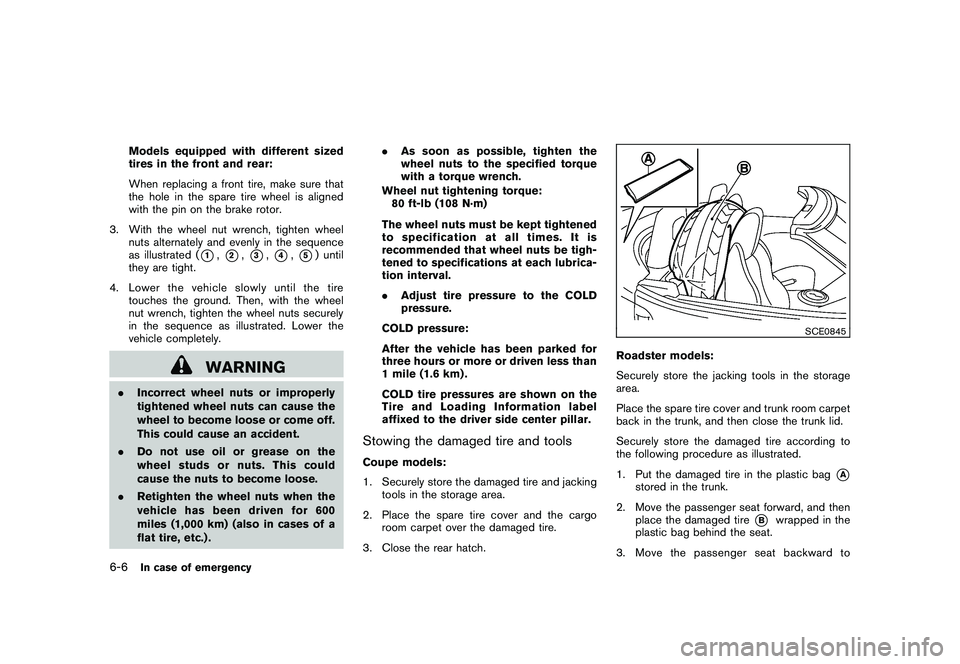
Black plate (312,1)
Model "Z34-D" EDITED: 2009/ 9/ 10
Models equipped with different sized
tires in the front and rear:
When replacing a front tire, make sure that
the hole in the spare tire wheel is aligned
with the pin on the brake rotor.
3. With the wheel nut wrench, tighten wheel nuts alternately and evenly in the sequence
as illustrated (
*1,*2,*3,*4,*5) until
they are tight.
4. Lower the vehicle slowly until the tire touches the ground. Then, with the wheel
nut wrench, tighten the wheel nuts securely
in the sequence as illustrated. Lower the
vehicle completely.
WARNING
.Incorrect wheel nuts or improperly
tightened wheel nuts can cause the
wheel to become loose or come off.
This could cause an accident.
. Do not use oil or grease on the
wheel studs or nuts. This could
cause the nuts to become loose.
. Retighten the wheel nuts when the
vehicle has been driven for 600
miles (1,000 km) (also in cases of a
flat tire, etc.) . .
As soon as possible, tighten the
wheel nuts to the specified torque
with a torque wrench.
Wheel nut tightening torque: 80 ft-lb (108 N·m)
The wheel nuts must be kept tightened
to specification at all times. It is
recommended that wheel nuts be tigh-
tened to specifications at each lubrica-
tion interval.
. Adjust tire pressure to the COLD
pressure.
COLD pressure:
After the vehicle has been parked for
three hours or more or driven less than
1 mile (1.6 km) .
COLD tire pressures are shown on the
Tire and Loading Information label
affixed to the driver side center pillar.
Stowing the damaged tire and toolsCoupe models:
1. Securely store the damaged tire and jacking tools in the storage area.
2. Place the spare tire cover and the cargo room carpet over the damaged tire.
3. Close the rear hatch.
SCE0845
Roadster models:
Securely store the jacking tools in the storage
area.
Place the spare tire cover and trunk room carpet
back in the trunk, and then close the trunk lid.
Securely store the damaged tire according to
the following procedure as illustrated.
1. Put the damaged tire in the plastic bag
*A
stored in the trunk.
2. Move the passenger seat forward, and then place the damaged tire
*B
wrapped in the
plastic bag behind the seat.
3. Move the passenger seat backward to
6-6
In case of emergency
Page 313 of 409
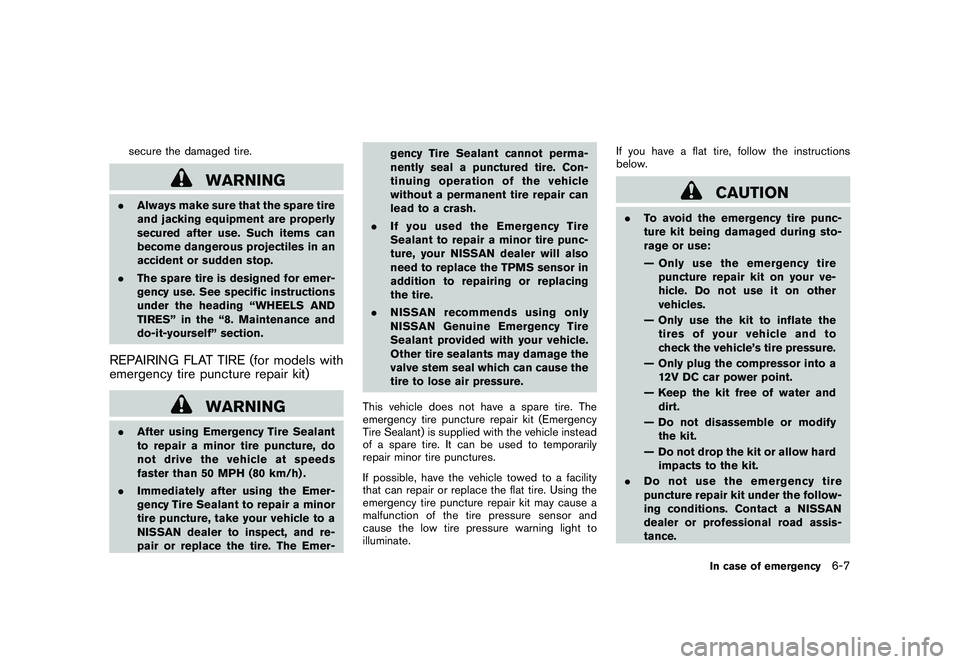
Black plate (313,1)
Model "Z34-D" EDITED: 2009/ 9/ 10
secure the damaged tire.
WARNING
.Always make sure that the spare tire
and jacking equipment are properly
secured after use. Such items can
become dangerous projectiles in an
accident or sudden stop.
. The spare tire is designed for emer-
gency use. See specific instructions
under the heading “WHEELS AND
TIRES” in the “8. Maintenance and
do-it-yourself” section.REPAIRING FLAT TIRE (for models with
emergency tire puncture repair kit)
WARNING
.After using Emergency Tire Sealant
to repair a minor tire puncture, do
not drive the vehicle at speeds
faster than 50 MPH (80 km/h) .
. Immediately after using the Emer-
gency Tire Sealant to repair a minor
tire puncture, take your vehicle to a
NISSAN dealer to inspect, and re-
pair or replace the tire. The Emer- gency Tire Sealant cannot perma-
nently seal a punctured tire. Con-
tinuing operation of the vehicle
without a permanent tire repair can
lead to a crash.
. If you used the Emergency Tire
Sealant to repair a minor tire punc-
ture, your NISSAN dealer will also
need to replace the TPMS sensor in
addition to repairing or replacing
the tire.
. NISSAN recommends using only
NISSAN Genuine Emergency Tire
Sealant provided with your vehicle.
Other tire sealants may damage the
valve stem seal which can cause the
tire to lose air pressure.
This vehicle does not have a spare tire. The
emergency tire puncture repair kit (Emergency
Tire Sealant) is supplied with the vehicle instead
of a spare tire. It can be used to temporarily
repair minor tire punctures.
If possible, have the vehicle towed to a facility
that can repair or replace the flat tire. Using the
emergency tire puncture repair kit may cause a
malfunction of the tire pressure sensor and
cause the low tire pressure warning light to
illuminate. If you have a flat tire, follow the instructions
below.
CAUTION
.
To avoid the emergency tire punc-
ture kit being damaged during sto-
rage or use:
— Only use the emergency tire
puncture repair kit on your ve-
hicle. Do not use it on other
vehicles.
— Only use the kit to inflate the tires of your vehicle and to
check the vehicle’s tire pressure.
— Only plug the compressor into a 12V DC car power point.
— Keep the kit free of water and dirt.
— Do not disassemble or modify the kit.
— Do not drop the kit or allow hard impacts to the kit.
. Do not use the emergency tire
puncture repair kit under the follow-
ing conditions. Contact a NISSAN
dealer or professional road assis-
tance.
In case of emergency
6-7
Page 314 of 409
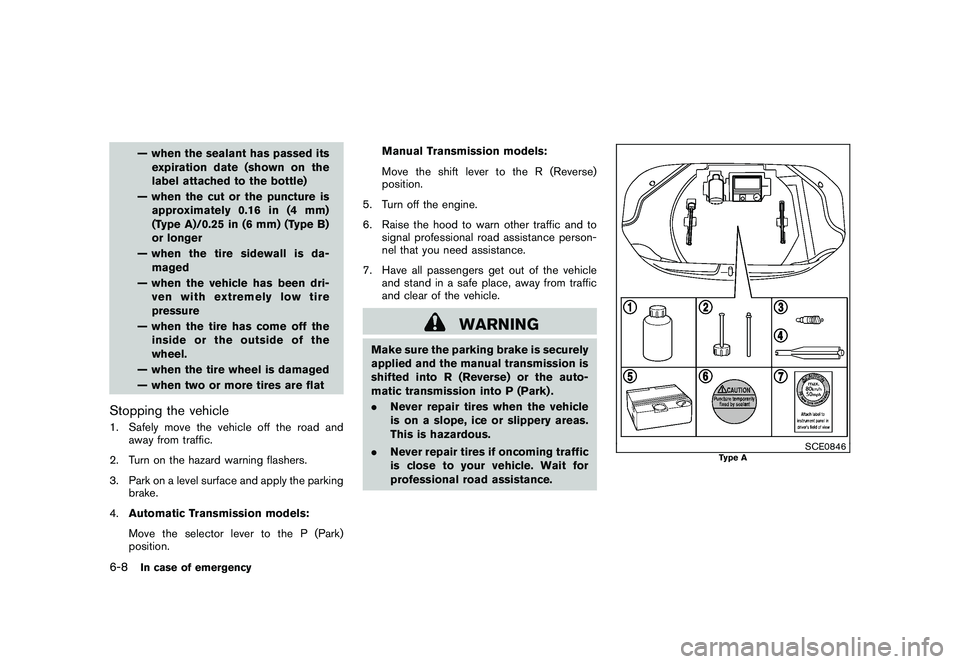
Black plate (314,1)
Model "Z34-D" EDITED: 2009/ 9/ 10
— when the sealant has passed itsexpiration date (shown on the
label attached to the bottle)
— when the cut or the puncture is approximately 0.16 in (4 mm)
(Type A)/0.25 in (6 mm) (Type B)
or longer
— when the tire sidewall is da- maged
— when the vehicle has been dri- ven with extremely low tire
pressure
— when the tire has come off the inside or the outside of the
wheel.
— when the tire wheel is damaged
— when two or more tires are flat
Stopping the vehicle1. Safely move the vehicle off the road and away from traffic.
2. Turn on the hazard warning flashers.
3. Park on a level surface and apply the parking brake.
4. Automatic Transmission models:
Move the selector lever to the P (Park)
position. Manual Transmission models:
Move the shift lever to the R (Reverse)
position.
5. Turn off the engine.
6. Raise the hood to warn other traffic and to signal professional road assistance person-
nel that you need assistance.
7. Have all passengers get out of the vehicle and stand in a safe place, away from traffic
and clear of the vehicle.
WARNING
Make sure the parking brake is securely
applied and the manual transmission is
shifted into R (Reverse) or the auto-
matic transmission into P (Park) .
.Never repair tires when the vehicle
is on a slope, ice or slippery areas.
This is hazardous.
. Never repair tires if oncoming traffic
is close to your vehicle. Wait for
professional road assistance.
SCE0846
Type A
6-8
In case of emergency
Page 315 of 409
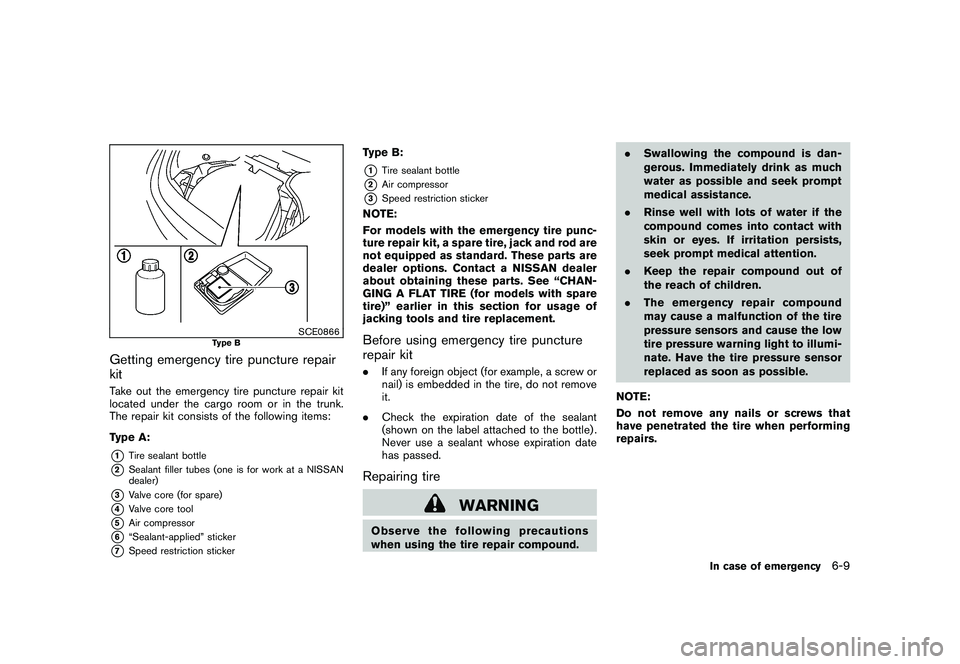
Black plate (315,1)
Model "Z34-D" EDITED: 2009/ 9/ 10
SCE0866
Type B
Getting emergency tire puncture repair
kitTake out the emergency tire puncture repair kit
located under the cargo room or in the trunk.
The repair kit consists of the following items:
Type A:*1
Tire sealant bottle
*2
Sealant filler tubes (one is for work at a NISSAN
dealer)
*3
Valve core (for spare)
*4
Valve core tool
*5
Air compressor
*6
“Sealant-applied” sticker
*7
Speed restriction sticker
Type B:*1
Tire sealant bottle
*2
Air compressor
*3
Speed restriction sticker
NOTE:
For models with the emergency tire punc-
ture repair kit, a spare tire, jack and rod are
not equipped as standard. These parts are
dealer options. Contact a NISSAN dealer
about obtaining these parts. See “CHAN-
GING A FLAT TIRE (for models with spare
tire)” earlier in this section for usage of
jacking tools and tire replacement.Before using emergency tire puncture
repair kit.If any foreign object (for example, a screw or
nail) is embedded in the tire, do not remove
it.
. Check the expiration date of the sealant
(shown on the label attached to the bottle) .
Never use a sealant whose expiration date
has passed.Repairing tire
WARNING
Observe the following precautions
when using the tire repair compound. .
Swallowing the compound is dan-
gerous. Immediately drink as much
water as possible and seek prompt
medical assistance.
. Rinse well with lots of water if the
compound comes into contact with
skin or eyes. If irritation persists,
seek prompt medical attention.
. Keep the repair compound out of
the reach of children.
. The emergency re pair compound
may cause a malfunction of the tire
pressure sensors and cause the low
tire pressure warning light to illumi-
nate. Have the tire pressure sensor
replaced as soon as possible.
NOTE:
Do not remove any nails or screws that
have penetrated the tire when performing
repairs.
In case of emergency
6-9
Page 316 of 409
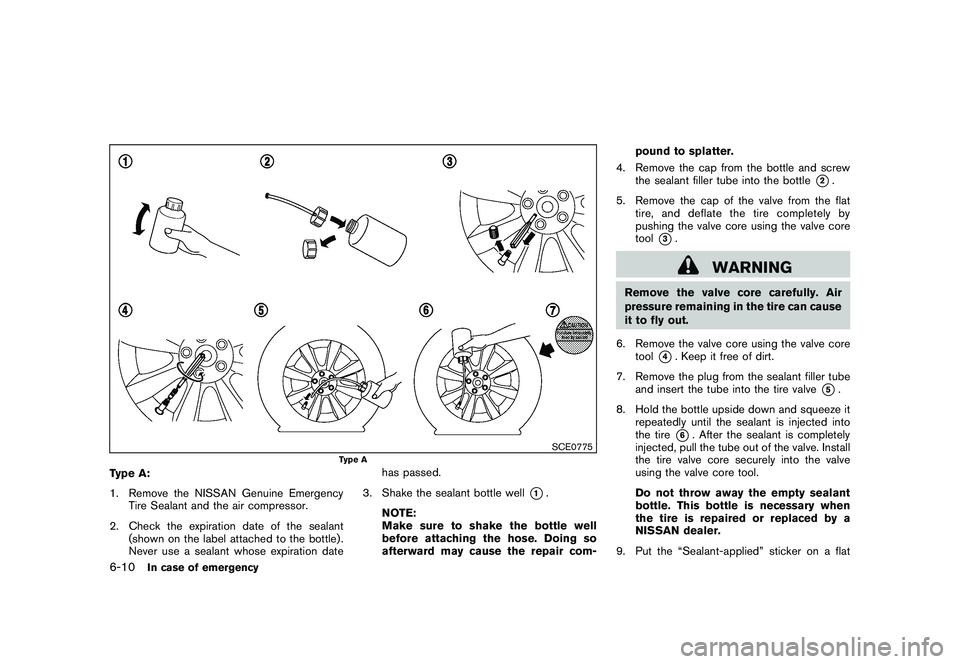
Black plate (316,1)
Model "Z34-D" EDITED: 2009/ 9/ 10
SCE0775
Type A
Type A:
1. Remove the NISSAN Genuine EmergencyTire Sealant and the air compressor.
2. Check the expiration date of the sealant (shown on the label attached to the bottle) .
Never use a sealant whose expiration date has passed.
3. Shake the sealant bottle well
*1.
NOTE:
Make sure to shake the bottle well
before attaching the hose. Doing so
afterward may cause the repair com- pound to splatter.
4. Remove the cap from the bottle and screw the sealant filler tube into the bottle
*2.
5. Remove the cap of the valve from the flat tire, and deflate the tire completely by
pushing the valve core using the valve core
tool
*3.
WARNING
Remove the valve core carefully. Air
pressure remaining in the tire can cause
it to fly out.
6. Remove the valve core using the valve core tool
*4. Keep it free of dirt.
7. Remove the plug from the sealant filler tube and insert the tube into the tire valve
*5.
8. Hold the bottle upside down and squeeze it repeatedly until the sealant is injected into
the tire
*6. After the sealant is completely
injected, pull the tube out of the valve. Install
the tire valve core securely into the valve
using the valve core tool.
Do not throw away the empty sealant
bottle. This bottle is necessary when
the tire is repaired or replaced by a
NISSAN dealer.
9. Put the “Sealant-applied” sticker on a flat
6-10
In case of emergency
Page 317 of 409
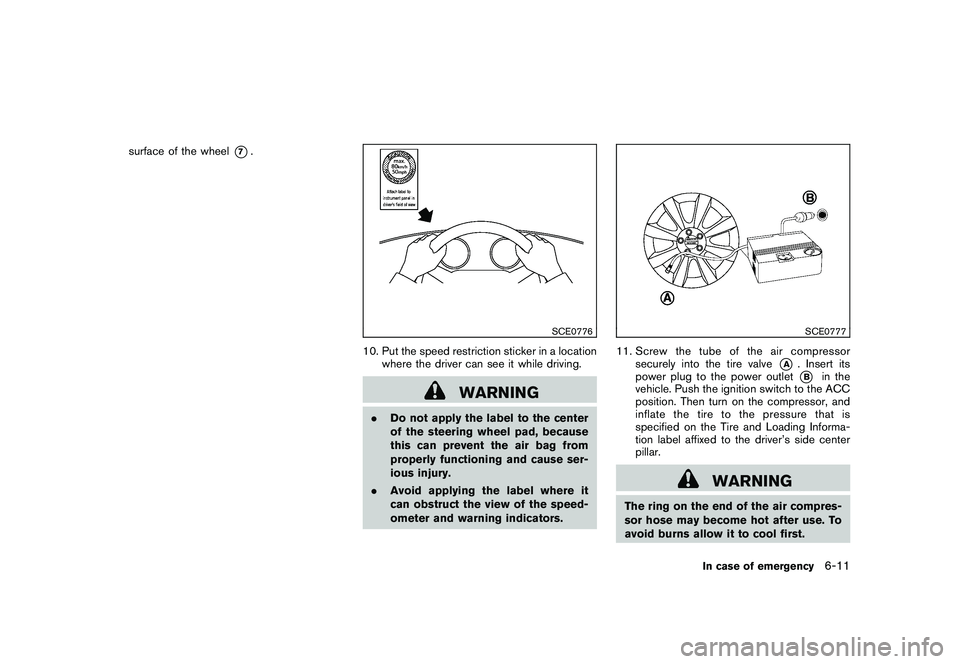
Black plate (317,1)
Model "Z34-D" EDITED: 2009/ 9/ 10
surface of the wheel
*7.
SCE0776
10. Put the speed restriction sticker in a locationwhere the driver can see it while driving.
WARNING
.Do not apply the label to the center
of the steering wheel pad, because
this can prevent the air bag from
properly functioning and cause ser-
ious injury.
. Avoid applying the label where it
can obstruct the view of the speed-
ometer and warning indicators.
SCE0777
11. Screw the tube of the air compressor
securely into the tire valve
*A
. Insert its
power plug to the power outlet*B
in the
vehicle. Push the ignition switch to the ACC
position. Then turn on the compressor, and
inflate the tire to the pressure that is
specified on the Tire and Loading Informa-
tion label affixed to the driver’s side center
pillar.
WARNING
The ring on the end of the air compres-
sor hose may become hot after use. To
avoid burns allow it to cool first.
In case of emergency
6-11
Page 318 of 409
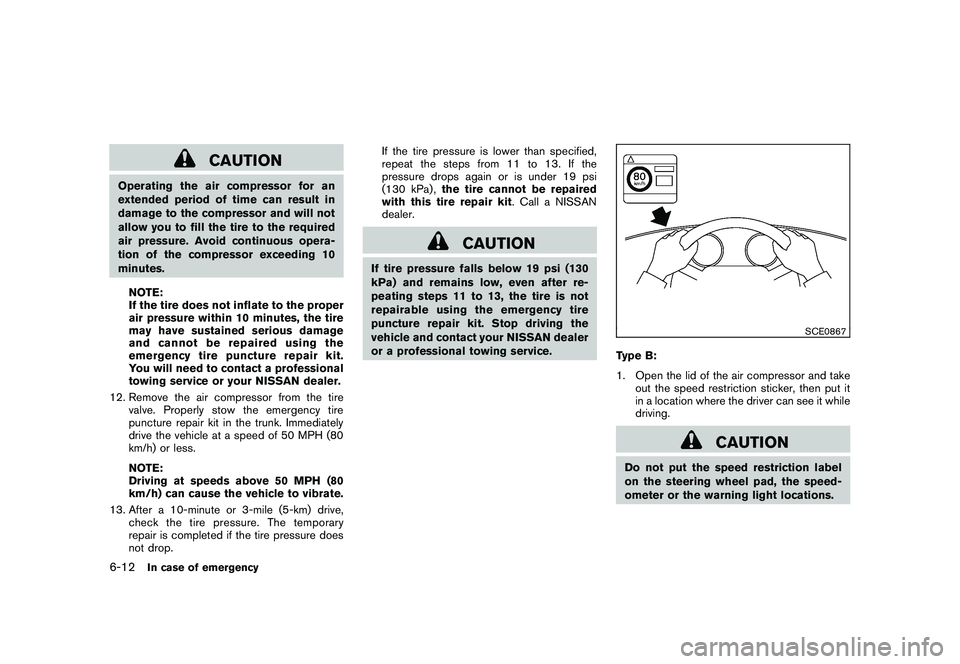
Black plate (318,1)
Model "Z34-D" EDITED: 2009/ 9/ 10
CAUTION
Operating the air compressor for an
extended period of time can result in
damage to the compressor and will not
allow you to fill the tire to the required
air pressure. Avoid continuous opera-
tion of the compressor exceeding 10
minutes.NOTE:
If the tire does not inflate to the proper
air pressure within 10 minutes, the tire
may have sustained serious damage
and cannot be repaired using the
emergency tire puncture repair kit.
You will need to contact a professional
towing service or your NISSAN dealer.
12. Remove the air compressor from the tire valve. Properly stow the emergency tire
puncture repair kit in the trunk. Immediately
drive the vehicle at a speed of 50 MPH (80
km/h) or less.
NOTE:
Driving at speeds above 50 MPH (80
km/h) can cause the vehicle to vibrate.
13. After a 10-minute or 3-mile (5-km) drive, check the tire pressure. The temporary
repair is completed if the tire pressure does
not drop. If the tire pressure is lower than specified,
repeat the steps from 11 to 13. If the
pressure drops again or is under 19 psi
(130 kPa),
the tire cannot be repaired
with this tire repair kit . Call a NISSAN
dealer.
CAUTION
If tire pressure falls below 19 psi (130
kPa) and remains low, even after re-
peating steps 11 to 13, the tire is not
repairable using the emergency tire
puncture repair kit. Stop driving the
vehicle and contact your NISSAN dealer
or a professional towing service.
SCE0867
Type B:
1. Open the lid of the air compressor and take out the speed restriction sticker, then put it
in a location where the driver can see it while
driving.
CAUTION
Do not put the speed restriction label
on the steering wheel pad, the speed-
ometer or the warning light locations.
6-12
In case of emergency
Page 319 of 409
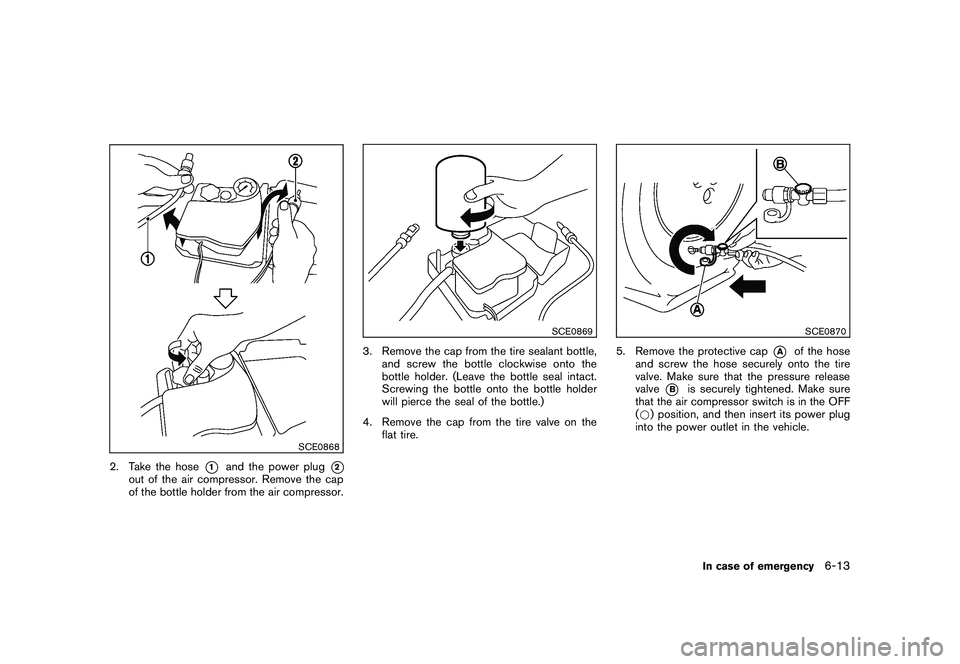
Black plate (319,1)
Model "Z34-D" EDITED: 2009/ 9/ 10
SCE0868
2. Take the hose
*1
and the power plug
*2
out of the air compressor. Remove the cap
of the bottle holder from the air compressor.
SCE0869
3. Remove the cap from the tire sealant bottle,and screw the bottle clockwise onto the
bottle holder. (Leave the bottle seal intact.
Screwing the bottle onto the bottle holder
will pierce the seal of the bottle.)
4. Remove the cap from the tire valve on the flat tire.
SCE0870
5. Remove the protective cap
*A
of the hose
and screw the hose securely onto the tire
valve. Make sure that the pressure release
valve
*B
is securely tightened. Make sure
that the air compressor switch is in the OFF
( * ) position, and then insert its power plug
into the power outlet in the vehicle.
In case of emergency
6-13
Page 320 of 409
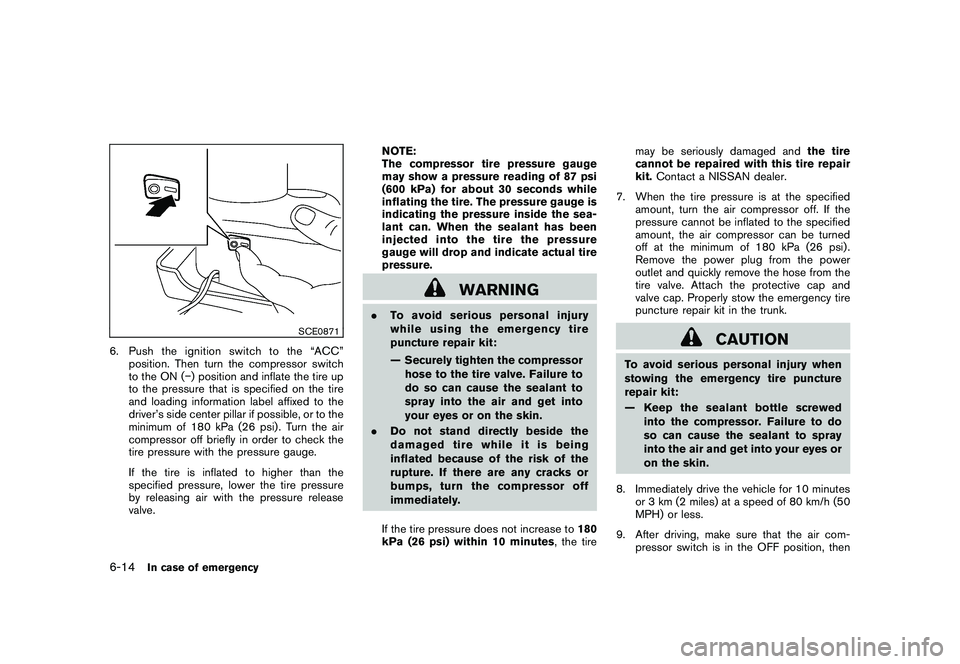
Black plate (320,1)
Model "Z34-D" EDITED: 2009/ 9/ 10
SCE0871
6. Pushtheignitionswitchtothe“ACC”position. Then turn the compressor switch
to the ON ( �) position and inflate the tire up
to the pressure that is specified on the tire
and loading information label affixed to the
driver’s side center pillar if possible, or to the
minimum of 180 kPa (26 psi) . Turn the air
compressor off briefly in order to check the
tire pressure with the pressure gauge.
If the tire is inflated to higher than the
specified pressure, lower the tire pressure
by releasing air with the pressure release
valve. NOTE:
The compressor tire pressure gauge
may show a pressure reading of 87 psi
(600 kPa) for about 30 seconds while
inflating the tire. The pressure gauge is
indicating the pressure inside the sea-
lant can. When the sealant has been
injected into the tire the pressure
gauge will drop and indicate actual tire
pressure.
WARNING
.
To avoid serious personal injury
while using the emergency tire
puncture repair kit:
— Securely tighten the compressor
hose to the tire valve. Failure to
do so can cause the sealant to
spray into the air and get into
your eyes or on the skin.
. Do not stand directly beside the
damaged tire while it is being
inflated because of the risk of the
rupture. If there are any cracks or
bumps, turn the compressor off
immediately.
If the tire pressure does not increase to 180
kPa (26 psi) within 10 minutes , the tiremay be seriously damaged and
the tire
cannot be repaired with this tire repair
kit. Contact a NISSAN dealer.
7. When the tire pressure is at the specified amount, turn the air compressor off. If the
pressure cannot be inflated to the specified
amount, the air compressor can be turned
off at the minimum of 180 kPa (26 psi) .
Remove the power plug from the power
outlet and quickly remove the hose from the
tire valve. Attach the protective cap and
valve cap. Properly stow the emergency tire
puncture repair kit in the trunk.
CAUTION
To avoid serious personal injury when
stowing the emergency tire puncture
repair kit:
— Keep the sealant bottle screwed
into the compressor. Failure to do
so can cause the sealant to spray
into the air and get into your eyes or
on the skin.
8. Immediately drive the vehicle for 10 minutes or 3 km (2 miles) at a speed of 80 km/h (50
MPH) or less.
9. After driving, make sure that the air com- pressor switch is in the OFF position, then
6-14
In case of emergency